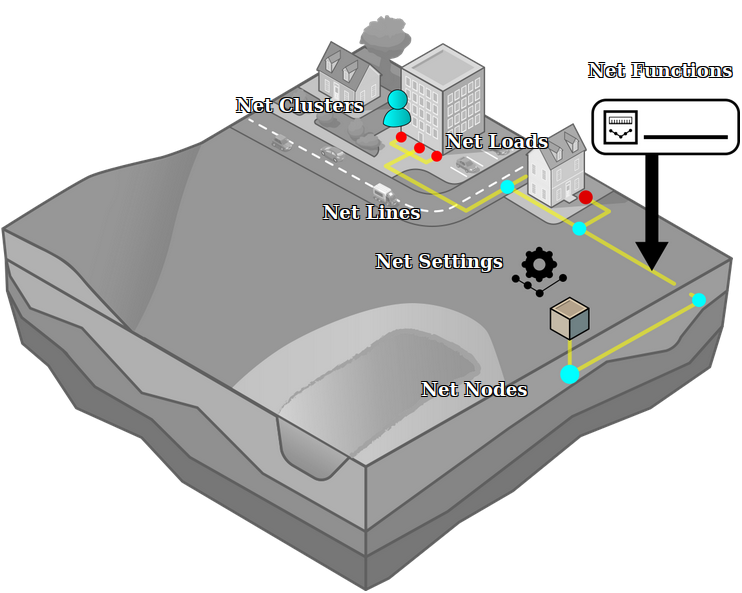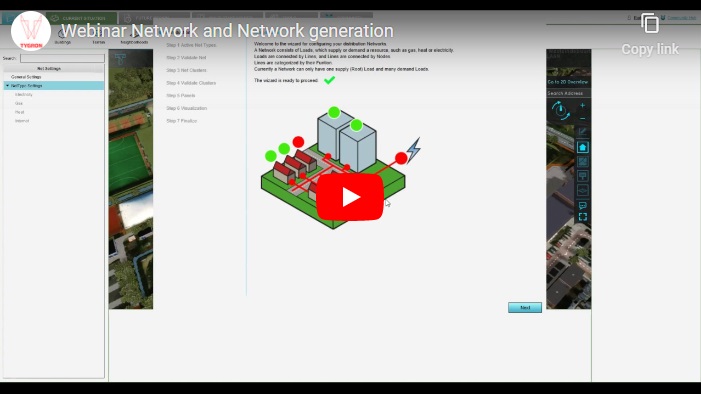Network: Difference between revisions
Jump to navigation
Jump to search

m (→Importing Data) |
No edit summary |
||
| (37 intermediate revisions by 5 users not shown) | |||
| Line 1: | Line 1: | ||
[[File:Api_current_situation_network.png|thumb|right|400px|Network with [[Net Node]]s connected by [[Net Line]]s, [[Net Load]]s clustered by [[Net Cluster]]s and configured by [[Net Setting]]s]] | |||
[[ | |||
Networks in the platform are composed of multiple constituent components: | |||
A | * [[Net Type]]: A categorization of the network. | ||
* [[Net Node]]s: A node present in one or more networks | |||
* [[Net Line]]s: A connection between two net nodes | |||
** Has an associated [[Net Function]], which in turn is related to a specific [[net type]]. | |||
* [[Net Load]]s: A definition of supply or demand in the network | |||
** Belongs to a particular [[Net Type]] | |||
** Is associated to [[Net Node]]. | |||
** Can be activated or deactivated with specific time states. | |||
* [[Net Cluster]]s: Cluster of net loads that provides group (de)activation. | |||
** Can be associated with [[Net Load]]s of different [[Net Type]]s | |||
* [[Net Setting]]s: Settings related to the configuration of a Network of a specific Net Type. | |||
===Restrictions on networks=== | ===Restrictions on networks=== | ||
* Networks cannot contain any cycles. All networks should be defined as a tree. If the network is not structured as a tree, network generation and other calculations may have unexpected results. | * Networks cannot contain any cycles. All networks should be defined as a tree. If the network is not structured as a tree, network generation and other calculations may have unexpected results. | ||
* A net node can be connected to 1, 2, or more [[net line]]s, except when that node is a [[net load|load node]]. In that case, a net node can only be connected to exactly 1 net line. | * A net node can be connected to 1, 2, or more [[net line]]s, except when that node is a [[net load|load node]]. In that case, a net node can only be connected to exactly 1 net line. | ||
* Behavior for networks linked with buildings which are altered during a session are undefined. When using network functionality, the buildings linked to by the network should not be demolished, [[upgrade]]d, sold to other stakeholders, or otherwise changed | * Behavior for networks linked with buildings which are altered during a session are undefined. When using network functionality, the buildings linked to by the network should not be demolished, [[Upgrade Type|upgrade]]d, sold to other stakeholders, or otherwise changed. | ||
{{article end | |||
|howtos= | |||
* | * [[How to generate a network using the network wizard]] | ||
* | * [[How to import an existing network]] | ||
* | * [[How to manually edit a network]] | ||
* | * [[How to check for errors when using the network wizard]] | ||
* | * [[How to check for errors when using the net validation panel]] | ||
|seealso= | |||
* [[Network Overview Overlay]] | |||
* [[Network Ownership Overlay]] | |||
* [[Network Distance Overlay]] | |||
|videos= | |||
:[[File:Network_VT.jpg| link=https://youtu.be/k4WDyjdurU4|left|thumb|Network and network generation]] | |||
}} | |||
{{Template:Editor current situation nav}} | |||
Latest revision as of 15:14, 29 February 2024

Network with Net Nodes connected by Net Lines, Net Loads clustered by Net Clusters and configured by Net Settings
Networks in the platform are composed of multiple constituent components:
- Net Type: A categorization of the network.
- Net Nodes: A node present in one or more networks
- Net Lines: A connection between two net nodes
- Has an associated Net Function, which in turn is related to a specific net type.
- Net Loads: A definition of supply or demand in the network
- Net Clusters: Cluster of net loads that provides group (de)activation.
- Net Settings: Settings related to the configuration of a Network of a specific Net Type.
Restrictions on networks
- Networks cannot contain any cycles. All networks should be defined as a tree. If the network is not structured as a tree, network generation and other calculations may have unexpected results.
- A net node can be connected to 1, 2, or more net lines, except when that node is a load node. In that case, a net node can only be connected to exactly 1 net line.
- Behavior for networks linked with buildings which are altered during a session are undefined. When using network functionality, the buildings linked to by the network should not be demolished, upgraded, sold to other stakeholders, or otherwise changed.
How-to's
- How to generate a network using the network wizard
- How to import an existing network
- How to manually edit a network
- How to check for errors when using the network wizard
- How to check for errors when using the net validation panel
Videos
See also
